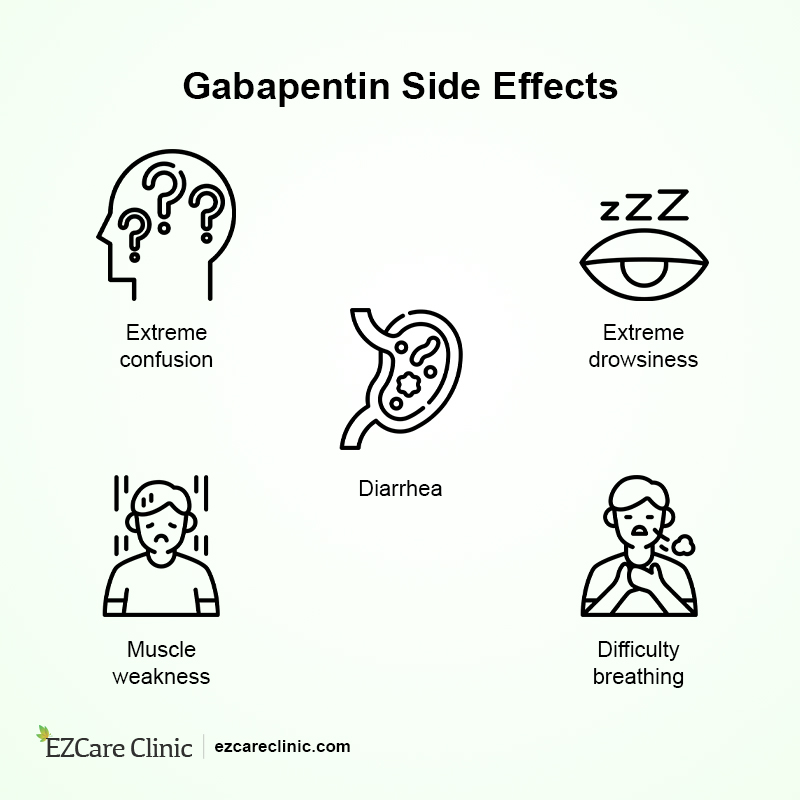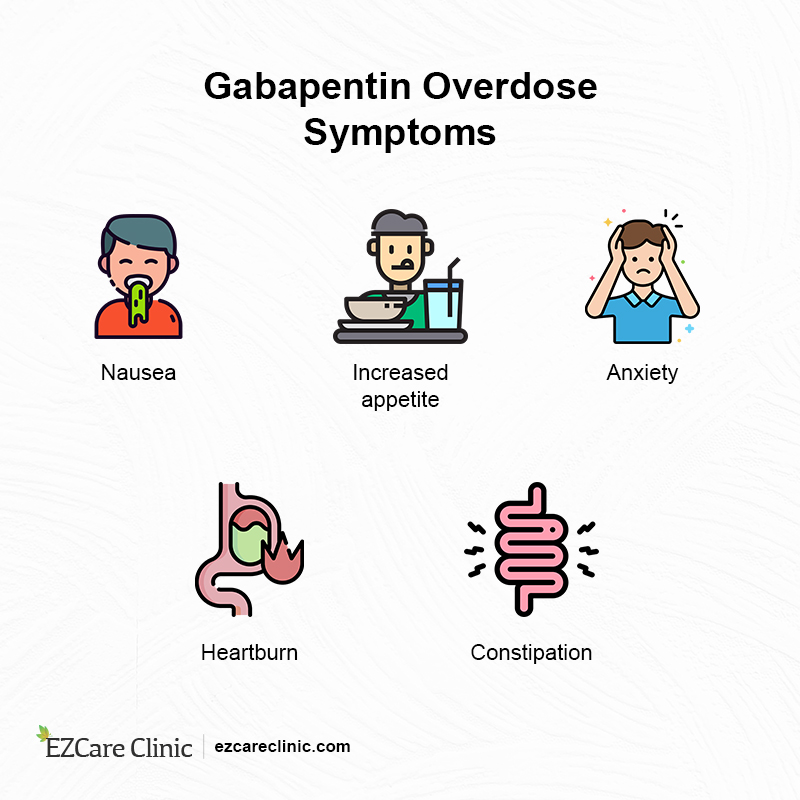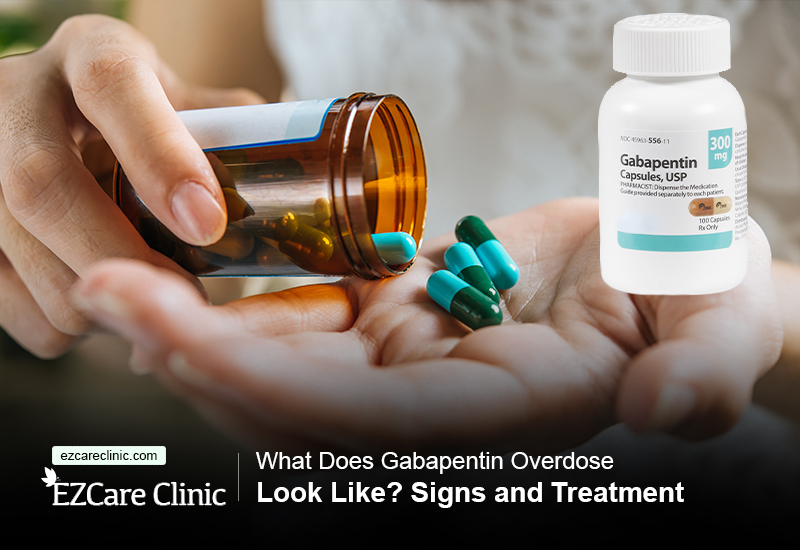The medications listed on this website are provided for informational purposes only. Their inclusion does not guarantee that they will be prescribed to any individual, as treatment decisions are ultimately at the discretion of healthcare providers. This list is not exhaustive, and healthcare providers may prescribe other medications, including non-stimulant options, based on the patient's unique health circumstances and needs.
Gabapentin, sold under the brand name Neurontin, is a relatively new drug used to treat nervous system disorders such as epilepsy, neuropathic pain, and other conditions. Due to its calming-high effect similar to opioids, cases of gabapentin abuse and overdose are on the rise.
Besides medication, there are other ways to treat depression– Click below to schedule your appointment with a mental health professional.
So, What Does Gabapentin Overdose Really Look Like?
Gabapentin overdose causes significant depression of the nervous system leading to:
- Drowsiness
- Blurry vision
- Abnormal heart rate
- Hypotension sedation
- Nausea
- Vomiting
- And, even coma
According to the National Center for Health Statistics, a prescription overdose of drugs such as gabapentin with psychoactive properties is spiking yearly.
Because of its effects and increasing popularity among drug and substance users, Neurontin has acquired street names such as gabbies and morontin.

Gabapentin Side Effects
Can You Overdose on Gabapentin?
Yes! Although Neurontin does not modulate the same receptors as opioids, gabapentin overdose looks like cannabis toxicity.
Unfortunately, for gabapentin, there’s no antidote, and permanent brain damage is likely to occur despite overdose symptom resolution.
What Is Gabapentin?
The FDA approves gabapentin for seizure disorders but has multiple off-label uses. Although Neurontin is prescribed for numerous conditions, the exact mechanism of action remains unclear.
Generally, gabapentin is a safe drug with a minimal side-effect profile. Very few reported cases of gabapentin’s serious side effects or toxicity partially contribute to the drug’s popularity.
Click below to schedule your appointment with a mental health professional and get the side effects of gabapentin treated.
Uses of Gabapentin
Introduced in 1993, gabapentin is FDA-approved for treating seizure disorders and post-herpetic pain, neuropathic pain that occurs following Shingles disease.
However, the drug has several off-label indications, such as the treatment of mood disorders.
Mainly, doctors prescribe gabapentin for unapproved uses.
These include management of:
- Bipolar disorder
- Attention-deficit- hyperactivity disorder
- Migraine
- Alcohol withdrawal seizures
- Complex regional pain syndrome
- Diabetic neuropathy
What Are the Side Effects of Using Gabapentin?
Like any other drug, even using gabapentin within the prescription parameters can bring about some undesired results.
For instance, those who take Neurontin for either the approved or the off-label conditions usually experience thought and behavior changes, including suicidal ideations.
Other side effects that are likely to arise from gabapentin usage include:
- Poor coordination
- Dizziness
- Tremors
- Unusual eye movements
- Double vision
Some individuals also experience:
- Temporary loss of memory
- Depression
- Restlessness
- Panic attacks
It’s not unlikely for patients taking gabapentin to display impulsive behavior and aggressiveness or anxiety symptoms.
Can You Get High on Gabapentin?
Since gabapentin does not affect the receptors modulated by common intoxicants like opioids,
The risk of abuse or addiction is relatively low when patients take gabapentin as prescribed. However, taking the drug in combination with other medications heightens the likelihood of getting high even if a doctor prescribed the use.
Some of the indicators that you’re possibly getting high on gabapentin include euphoria, a feeling of calmness, and behaviors resembling events of marijuana intoxication.
If you’re taking gabapentin together with other medications such as muscle relaxants and anti-anxiety drugs, there’s an increased risk of developing severe symptoms of gabapentin overdose.
Gabapentin Overdose
Gabapentin overdose is a rare event resulting from either intentional overconsumption of the drug or unintended toxicity.
In most cases, the overdose occurs when polydrug users
Heroin users are more likely to suffer from gabapentin overdose as the illegal distributors usually mix this drug with heroin in unregulated amounts.
While gabapentin overdose resembles opioid toxicity, no antidote can be used to reverse the Neurontin excess. Consequently, symptomatic relief is the primary method of managing such toxicity.

Gabapentin Overdose Symptoms
Signs of Gabapentin Overdose
According to the FDA, gabapentin overdose occurs with the ingestion of 49 or more grams of the drug.
Indicators of Neurontin toxicity include:
- Poor muscle coordination, known as ataxia
- Difficulty in breathing
- Drooping eyelids (ptosis) and double vision
- Lethargy and drowsiness
- Significant sedation
- Slurred speech
- Reduced activity
How Do You Handle a Case of Gabapentin Overdose?
Even though gabapentin toxicity is a rare occurrence, it may be fatal when it happens.
Therefore, you need to act swiftly when handling a case of gabapentin overdose. Interference of oxygen supply to the brain is the biggest threat in individuals who have overdosed on Neurontin.
So, here’s what to do in case of gabapentin overdose. First, ensure the airway is patent, the patient is breathing, and the pulses are present. If unconscious, call the emergency department for immediate care.
Before help arrives and other medical treatments begin, you need to:
- Roll the person to their side
- Bend the lower limb at the hip and the knee
- Slightly tilt the head back to help maintain an open airway
- Try to keep the individual calm
Schedule your appointment with a licensed professional to get the most suitable treatment for depression.
Detox and Treatment of Gabapentin Overdose
When you stop taking gabapentin suddenly after periods of heavy use, the likelihood of severe withdrawal features, including seizures, is quite high. Therefore, when quitting gabapentin abuse, you should seek professional help.
A detox is a treatment approach that allows slow release of gabapentin from the body averting the risk of withdrawal seizures. Once you complete detox, you can join one of the treatment programs for gabapentin addiction.
Sources
- Gabapentin: An update of its pharmacological properties and therapeutic use in epilepsy. (2011)
Source link - Gabapentin for Off-Label Use: Evidence-Based or Cause for Concern? (2018)
Source link - Review about gabapentin misuse, interactions, contraindications and side effects. (2017)
Source link
At EZCare, we walk you through the treatment plan. Need help? Get in touch with our team today. Book an appointment or call us at (415) 966-0848.





